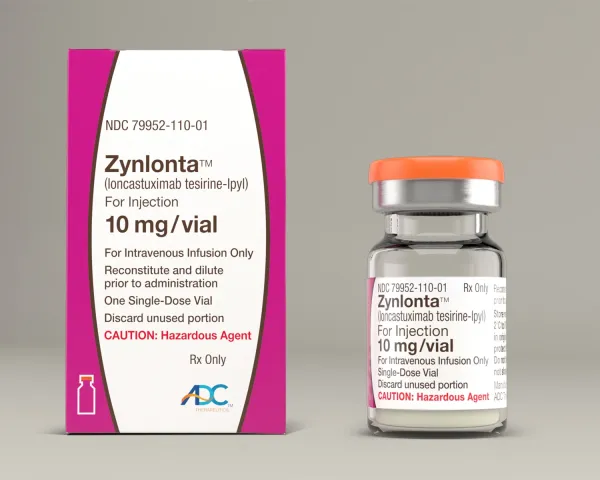Zynlonta Side Effects
Generic name: loncastuximab tesirine
Medically reviewed by Drugs.com. Last updated on Jan 22, 2025.
Note: This document provides detailed information about Zynlonta Side Effects associated with loncastuximab tesirine. Some dosage forms listed on this page may not apply specifically to the brand name Zynlonta.
Applies to loncastuximab tesirine: intravenous powder for solution.
Serious side effects of Zynlonta
Along with its needed effects, loncastuximab tesirine (the active ingredient contained in Zynlonta) may cause some unwanted effects. Although not all of these side effects may occur, if they do occur they may need medical attention.
Check with your doctor or nurse immediately if any of the following side effects occur while taking loncastuximab tesirine:
More common side effects
- black, tarry stools
- bleeding gums
- blood in the urine or stools
- body aches or pain
- chills
- cough
- ear congestion
- fever
- headache
- increased sensitivity of the skin to sunlight
- itching, skin rash
- loss of voice
- lower back or side pain
- muscle or bone pain
- pain or tenderness around the eyes and cheekbones
- painful or difficult urination
- pale skin
- pinpoint red spots on the skin
- redness or other discoloration of the skin
- severe sunburn
- sore throat
- stuffy or runny nose
- swelling of the hands, ankles, feet, or lower legs
- swelling or puffiness of the face
- tightness in the chest
- trouble breathing
- ulcers, sores, or white spots in the mouth
- unusual bleeding or bruising
- unusual tiredness or weakness
Less common side effects
- anxiety
- blistering, crusting, irritation, itching, or reddening of the skin
- blue or pale skin
- chest pain, possibly moving to the left arm, neck, or shoulder
- confusion
- cracked, dry, scaly skin
- darkening of the skin
- dizziness
- dry cough
- fainting
- fast heartbeat
- general feeling of discomfort or illness
- lightheadedness
- rapid, shallow breathing
- sneezing
- thickening of bronchial secretions
Other side effects of Zynlonta
Some side effects of loncastuximab tesirine may occur that usually do not need medical attention. These side effects may go away during treatment as your body adjusts to the medicine. Also, your health care professional may be able to tell you about ways to prevent or reduce some of these side effects.
Check with your health care professional if any of the following side effects continue or are bothersome or if you have any questions about them:
More common side effects
- back pain
- constipation
- decreased appetite
- diarrhea
- difficulty in moving
- joint pain
- lack or loss of strength
- muscle aches, cramps, or stiffness
- nausea
- stomach pain
- swollen joints
- unusual drowsiness, dullness, or feeling of sluggishness
- vomiting
For healthcare professionals
Applies to loncastuximab tesirine: intravenous injection.
General adverse events
The most common (greater than 20%) adverse reactions, including laboratory abnormalities, were thrombocytopenia, increased gamma-glutamyltransferase, neutropenia, anemia, hyperglycemia, transaminase elevation, fatigue, hypoalbuminemia, rash, edema, nausea, and musculoskeletal pain.[Ref]
Immunologic
- Common (1% to 10%): Sepsis/escherichia sepsis/septic shock
- Frequency not reported: Immunogenicity[Ref]
Local
- Uncommon (0.1% to 1%): Infusion site extravasation[Ref]
Musculoskeletal
- Very common (10% or more): Musculoskeletal pain (e.g., musculoskeletal pain, musculoskeletal chest pain, musculoskeletal discomfort, back pain, limb discomfort, myalgia, neck pain, non-cardiac chest pain, pain in extremity) (23%)[Ref]
Metabolic
- Very common (10% or more): Glucose increased (48%), edema (e.g., edema, face edema, generalized edema, peripheral edema, ascites, fluid overload, peripheral swelling, swelling, swelling face) (28%), anorexia (15%)[Ref]
Hepatic
- Very common (10% or more): AST increased (37%), ALT increased (34%)[Ref]
Respiratory
- Very common (10% or more): Dyspnea/dyspnea exertional (13%), pleural effusion (10%), upper respiratory tract infection (e.g., upper respiratory tract infection, upper respiratory tract congestion, nasopharyngitis, rhinitis, rhinovirus infection, sinusitis (10%)
- Common (1% to 10%): Pleural effusion (Grade 3), pneumonia/pneumonitis, pleuritis[Ref]
Other
Hematologic
- Very common (10% or more): Platelets decreased (58%), neutrophils decreased (52%), hemoglobin decreased (51%), albumin decreased (37%), neutropenia (Grade 3 or 4) (32%), thrombocytopenia (20%), anemia (12%)
- Common (1% to 10%): Febrile neutropenia[Ref]
Cardiovascular
- Common (1% to 10%): Pericarditis[Ref]
Dermatologic
- Very common (10% or more): Rash (e.g., rash erythematous, rash maculopapular, rash pruritic, rash pustular, erythema, generalized erythema, dermatitis, dermatitis acneiform, dermatitis bullous, dermatitis exfoliative generalized, palmar-plantar erythrodysesthesia syndrome) (30%), pruritus (12%), photosensitivity reaction (10%)
- Common (1% to 10%): Hyperpigmentation, dermatitis[Ref]
Gastrointestinal
- Very common (10% or more): Nausea (23%), diarrhea (17%), abdominal pain (e.g., abdominal pain, abdominal discomfort, abdominal pain lower, abdominal pain upper) (14%), vomiting (13%), constipation (12%)
- Common (1% to 10%): Pericardial effusion[Ref]
References
1. (2021) "Product Information. Zynlonta (loncastuximab tesirine)." ADC Therapeutics America
More about Zynlonta (loncastuximab tesirine)
- Check interactions
- Compare alternatives
- Pricing & coupons
- Drug images
- Dosage information
- During pregnancy
- FDA approval history
- Drug class: miscellaneous antineoplastics
- Breastfeeding
- En español
Patient resources
Professional resources
Related treatment guides
Further information
Zynlonta side effects can vary depending on the individual. Always consult your healthcare provider to ensure the information displayed on this page applies to your personal circumstances.
Note: Medication side effects may be underreported. If you are experiencing side effects that are not listed, submit a report to the FDA by following this guide.

